Revell-Germany 1/48 Me-410B-2
The Messeschmitt Me-410 was essentially a redesigned Me-210, with a lengthened fuselage and DB603 engines rather than the DB605 of the earlier design. This redesign solved the problems of the Me-210, which were so difficult that it was deemed prudent to give the redesigned modification a new designation number to remove all connection with the previous failure.
The Me-410A Schnellbomber appeared in late 1942, and proved an elusive target when used for night bombing missions over England in 1943. The Me-410B Zerstorer appeared on operations in 1943, and proved successful when attacking unescorted American daylight bomber formations during the summer and fall of 1943. The airplane was no match for P-38s, P-47s or P-51s as these escorts began appearing with sufficient range to escort the bombers all the way to and from the target. On March 6, 1944, during the first daylight raid on Berlin, Me-410s of ZG 76 shot down 8 B-17s, while losing 16 of their own force in return. By the late spring of 1944, the vulnerable Me-410s had been removed from operations despite being Hitler's favorite bomber destroyers.
The Me-410B-2/U4 used the 50mm Bordkanone series weapon, the BK‑5 with 22 rounds (21 rounds to be loaded and 1 extra round already in the cannon). The cannon was developed from the Panzer III tank main armament, the KwK 39 L/60, and allowed the Me 410 to fire at from a range of 3,000 feet, which put the attacker out of range of the bomber's defensive armament; one hit wwas sufficient to destroy either a B-17 or B-24. The BK-5 frequently jammed; coupled with the limited ammunition supply and the extra 1,200 lb of the cannon, the heavy bomber destroyer was nearly helpless when confronted by escorts and was the first version of the Me-410 to be taken off operations in 1944.
THE KIT
The 1/48 Me-410 first appeared in 1998, released by Pro-Modeler. The later version with the 50mm cannon was a limited release by Revell in 2003. In 2013, Meng released a 1/48 Me-410 that could be finished with any of the armament options of the series. The kit was judged by modelers to be not that much of an advancement over the earlier Monogram kit, though it was priced about four times the price of the earlier kit.
CONSTRUCTION
Construction pretty much starts with the cockpit, which provides good detail if care is taken in painting. I added seatbelts from an Eduard photoetch set, which is really all that is needed to have a good-looking cockpit.
Parts fit throughout the kit is good, and I did not use any filler other than getting a good fit with the open armament bay doors that I decided to shut. Getting the separate canopy structure and the gunsight assembled is fiddly, and one is required as a result to assemble the two-part canopy around those parts. I used Micro KrystalKlear white glue to attach these parts together and then attach them to the fuselage so there were no gaps.
I used Gunze-Sangyo paints, with my own mixtures of RLM74 and RLM75, with the camouflage freehanded.
For markings, I used an old Aeromaster decal sheet that had been released back when the original kit was released by Pro-Modeler to do an Me-410B-2/U4 of I/ZG 76 as flown in the fall and winter of 1943, since this sheet also included a swastika, which the kit decals did not. When all that was done, I unmasked the canopy and mounted the pilot's and gunner's hatches in the open position.
CONCLUSIONS
The Monogram/Revell kit is an underappreciated kit that is still to be found at dealers like Rare Plane Detective and on dealers' tables at model shows, and represents good value at the usual prices of $20-$30, and is a kit that builds into a nice model. It has no insuperable difficulties, the only “fiddly” bit being the fit and assembly of the two canopy sections.
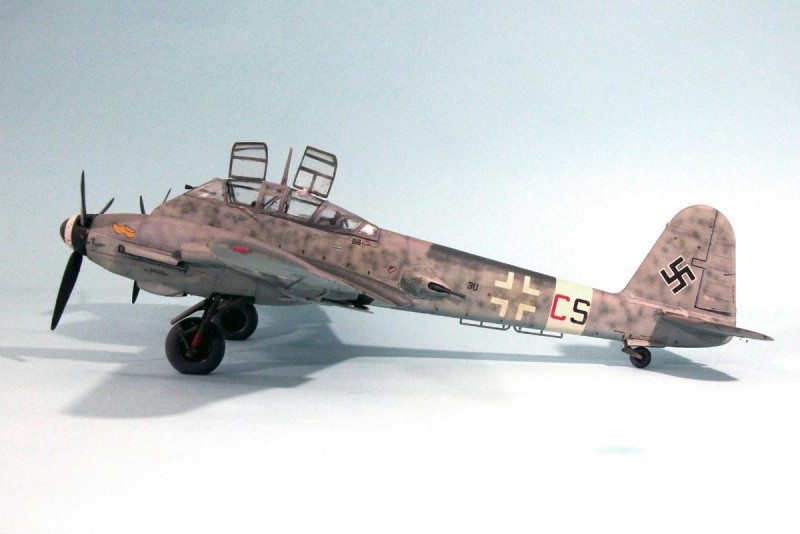
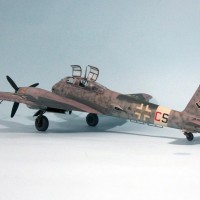
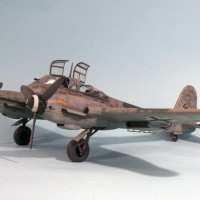
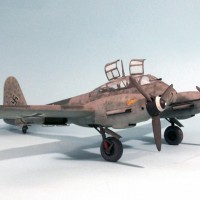
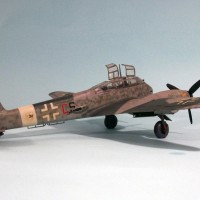
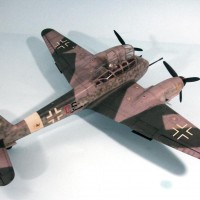
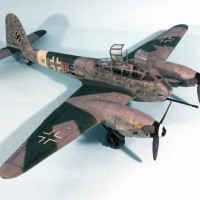
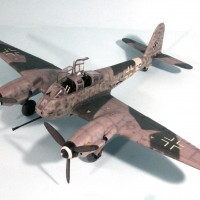
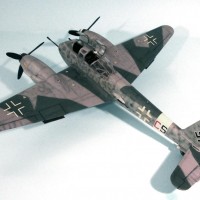
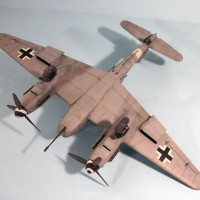
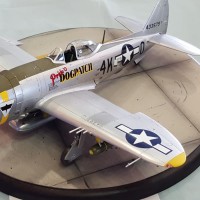
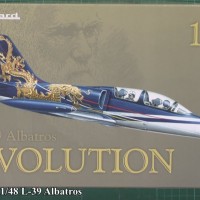
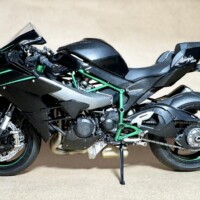
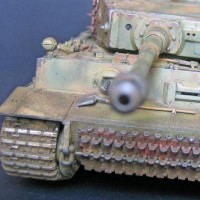
One of your better builds IMO, TC...I like everything about it.
Well done, Tom. Certainly a well-done but under appreciated kit. I find that plane to be very interesting.
Tom that is an awesome build and not an easy one either. You got the camo just right. Awesome job.
Tom that is one STUNNING Hornisse. I also have the Pro Modeler offering and you have inspired me to get mine onto the build pile. Awesome build. Well done!
That's an accomplished example of your skill. Whenever I see any of Willy's twin-engine designs, the theory that if it looks right, it'll fly right. All 3 of his zerstoerers looked right to my eyes but, with the possible exception of the 210, it seems to me that the only reason their combat record proved otherwise was that they were often pushed into roles for which they were ill-equipped, simply to fill the gaps that were exposed in an ill-prepared war machine when faced with serious opposition. Love the mottling on this one. Paul
Looks great - I really like the mottling you achieved on this one.
Nice 410 Tom, really like what you did with the mottling. I built one several years ago while on my reintroduction road to modeling. Like you I thought it was an excellent kit both in cockpit detail and overall parts fit. No putty was used on mine as well. As mentioned that two piece canopy gave me some heartburn as I wasn't sure how to attach it. I do now.
Congrats Tom, very nice build! Another nice feature about this plane was also the central control on the self defense armament. All the gunner had to do was aim an optical range finder and pull the trigger. Very advanced mechanical computing!
As others have said, the mottling is perfect and the build perfectly reflects the aircraft. As always we get an interesting story, a history lesson, and a kit review - all in one!
Great paintwork, Tom!
Inspirational build. Commander Eric Brown said "it was a real knife-edger if ever I flew one."